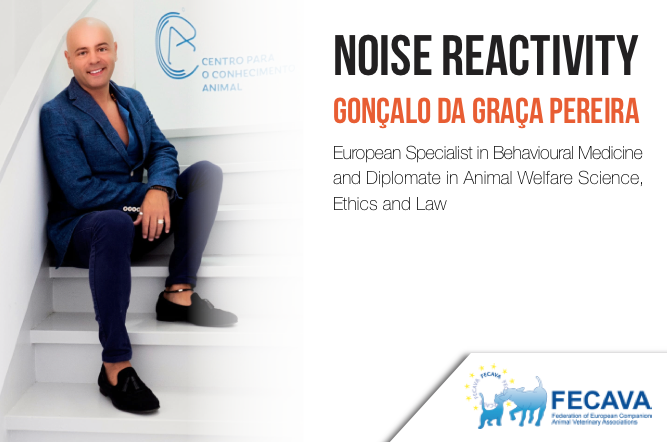
Noise reactivity
Introduction
Anxiety disorders, fear, and phobias are among the most common behavioral problems of companion animals. These problems include generalized anxiety, separation-related problems, and phobias of specific stimuli such as storms, fireworks, or other noises. In each of these disorders, affected animals are in a state of heightened arousal and distress. They may cause damage to their surroundings or themselves as an expression of their anxiety. As such, anxiety disorders represent an important welfare issue for affected dogs and may negatively impact the human-animal bond, becoming one of the major reasons for relinquishment of animals to shelters.
Signs of light fear (subtle and commonly not understandable as fear by the owners) to severe uncontrollable fear (generally known as phobias) are common causes of referral to behavioral practices. The most commonly reported reactivity is noise (also known as a sound phobia), being fireworks and thunderstorms the most common triggers. Sometimes, dogs with separation-related problems can have their origin in sound phobias.
Assessment and Diagnose
We can consider 2 different phases that each animal has when arriving at our consultation. To make it easier, it will be considered phase 1 and phase 2.
Phase 1
The animals show signs of fear only during noise exposure. During this event, the animal tries to hide from fear-inducing events. The dog is able to control the behavioral expression of its emotional reaction by predicting events and engaging in a coping strategy to control the behavioral expression of its emotional state.
Phase 2
Fear becomes more severe and avoiding or predicting strategies fail. The sound is now experienced in a sensitizing context that will lead to more serious complications. From these complications, there are 2 that are very important. The first one is the excessive sensitivity to sounds, especially the unexpected ones. The other important complication is the generalization that can occur in this phase. The generalization can be related to individual sounds, but also to contexts and predictive cues associated with this trigger.
It is really fundamental to keep in mind that any phase 1 can progress to phase 2.
Management of noise-related behavior problems
The aim of managing this behavioral problem is to support the animal to develop coping strategies. The environmental management (guarantee always access to hiding places or refuges), along with the alterations in human interaction are both re required to make good management. Owners should never use positive punishment or even force the animal to face the sound that develops fear signs. Instead, owners should act as role models, not being bothered with the sounds and nor worried. Ignoring the fearful animal is also something inadequate, but still being recommended.
Giving support and asking for an alternative and incompatible behavior (previously trained with positive reinforcement) will help the animal to move its emotional state to a positive one.
Treatment
Treatment is based on 3 strategies: behavioral modification, pharmacological intervention, and pheromone therapy.
Behavioral modification
Desensitization and counter-conditioning are the basis to treat these animals. However, client understanding of the processes involved is often poor. Thus, apart from making sure the client understands exactly all the steps, having a trustable animal trainer or a behaviorist can be fundamental to support the behavioral modification plan, which the main goal is changing the negative emotional state to a positive one. There are many limitations in the treatment, and every step must be well previously thought to guarantee no mistakes can happen.
Pharmacological intervention
Drugs are appropriate if: generalization is wide, complications exist, welfare is affected. The exposure to a fear-inducing event may cause a relapse, worsen the behavioral condition, and cognitive impairment may be present as well.
Despite the choice of the different drugs that one can use, we must never use acepromazine to increase the sound sensitivity and reduce escape response. It can cause disorientation and confusion, including disinhibited aggression. Its use can cause progression to stage 2.
Pheromone therapy
Pheromones can play a long term in long term treatment approaches. Adaptil® or Feliway® can increase the appeasing qualities of the environment supporting the behavioral modification plan.
Conclusions
The effects on the quality of life and welfare of the animal concerned can be significant and they do deserve appropriate management and/or treatment. When left without appropriate therapeutic intervention, such conditions are likely to worsen, not only in intensity but also through the effects of generalization.
 Gonçalo da Graça Pereira,
Gonçalo da Graça Pereira,
European Specialist in Behavioural Medicine and
Diplomate in Animal Welfare Science, Ethics and Law
Leave a reply

The Rice Purity Test is a 100-question survey assessing a person’s innocence in worldly matters. Originating from Rice University, it’s often taken by college students to compare life experiences and gauge their "purity." Lower scores indicate more worldly experiences. Website : https://ricepuritytesttool.com/
Reply